11 Texas Plants You Didn’t Know You Could Eat
Recipes and tips for wild and unconventional foods—from chile pequin to yaupon—that you can find in your own backyard.
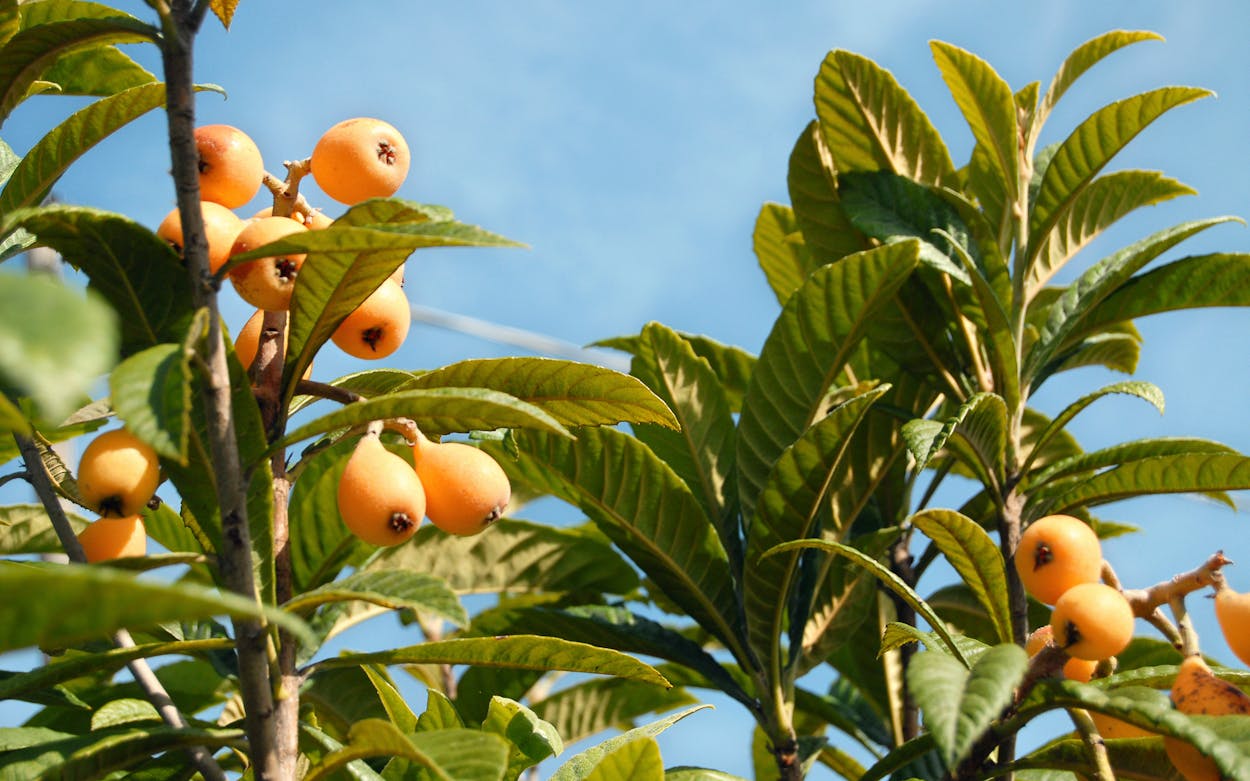
How many edible plants are growing in your yard right now? It’s almost certainly more than you think. While writing this story, I counted at least six consumable species that have flourished in my Central Austin backyard—and that’s excluding all the typical herbs and vegetables we grow in our garden. My list included yaupon holly, marigold, dandelion, winecup, mulberry, and chickweed, most of which I had no idea I could eat.
Like most Texas Monthly readers, I’ll probably never be a forager—my anxiety level is too high for that, especially after watching a spine-chilling episode of Midsomer Murders in which the victim dies by amanita mushroom, better known as the destroying angel. (Fun fact: this deadliest genus of mushrooms, which can be fatal, flourishes in East and Central Texas.) Luckily, there’s a plethora of unconventional fruits, greens, herbs, and other foods you can plant in your garden, sample at a local farm, or (carefully) find thriving right outside your door. For advice, I turned to Mark Vorderbruggen, a lifelong forager based in Houston and founder of the website Foraging Texas, as well as Scooter Cheatham and Lynn Marshall, who run the Useful Wild Plants project in Austin. All three offer hands-on foraging classes (which Cheatham, delightfully, likes to call a “speedy weed feed”), and these are the best way to get started.
The experts stress the importance of safety above all else. “People often get what we call ‘chlorophyll fever,’ ” Marshall says, referring to enthusiastic novice foragers. “They start thinking that everything they see is Mother Nature’s bounty. Well, it isn’t.” Never rely on a book, website, or identification app such as iNaturalist to decide if a plant is safe to eat. Instead, join a class, go out with an experienced forager, and learn how to confirm multiple identifying features on each plant. “For mushrooms, you need to match up at least eight to ten structural features,” such as color, size, shape, and where it’s growing, Vorderbruggen says. “With plants, you can get away with five or six”—but more is always better, and again, if you’re a beginner, you should partner with someone who knows what they’re doing and is absolutely certain that a specific plant is safe to eat.
With those words of warning in mind, on to a list of edible Texas plants.
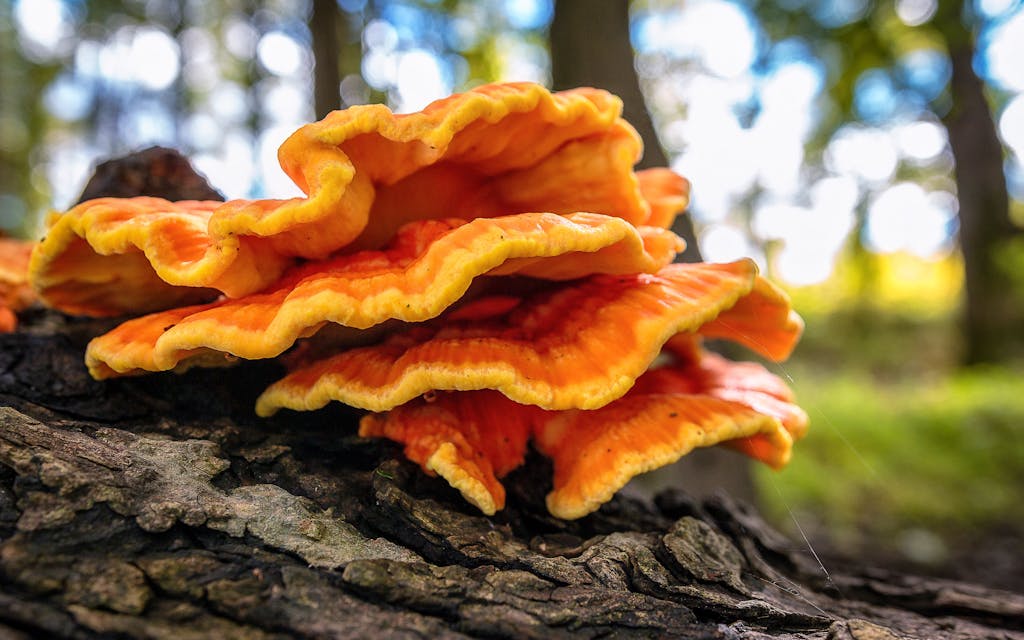
Chicken of the woods
Range: Central and North Texas
How to eat it: Sautéed with rice, pasta, and/or veggies
Okay, so it’s a fungus, not a plant. But the chicken of the woods mushroom is the gateway drug that introduced me to the world of wild, foraged, and unconventional foods. A friend dropped off some she’d gathered earlier that day in the woods near Lady Bird Lake, and I sautéed them with a little butter and garlic. The fresh, rich, umami flavor blew me away; I’d even venture to say it’s better than chicken, which can often be bland on its own.
Foraging for mushrooms requires ample caution. Since some species are deadly, you want to be absolutely certain of what you’re eating. That said, chicken of the woods is a good choice for beginners because it’s unmistakable. “It looks like a bunch of raw chicken breasts, stuck to a tree and coated with that orange Doritos cheese stuff,” Vorderbruggen says. Before biting into one, though, make sure to identify those aforementioned eight to ten structural features specific to the species, such as what surface it’s growing on (chicken of the woods prefers rotting trees) and the shape of the stem. You can also make a spore print, which is akin to taking a mushroom’s fingerprint.
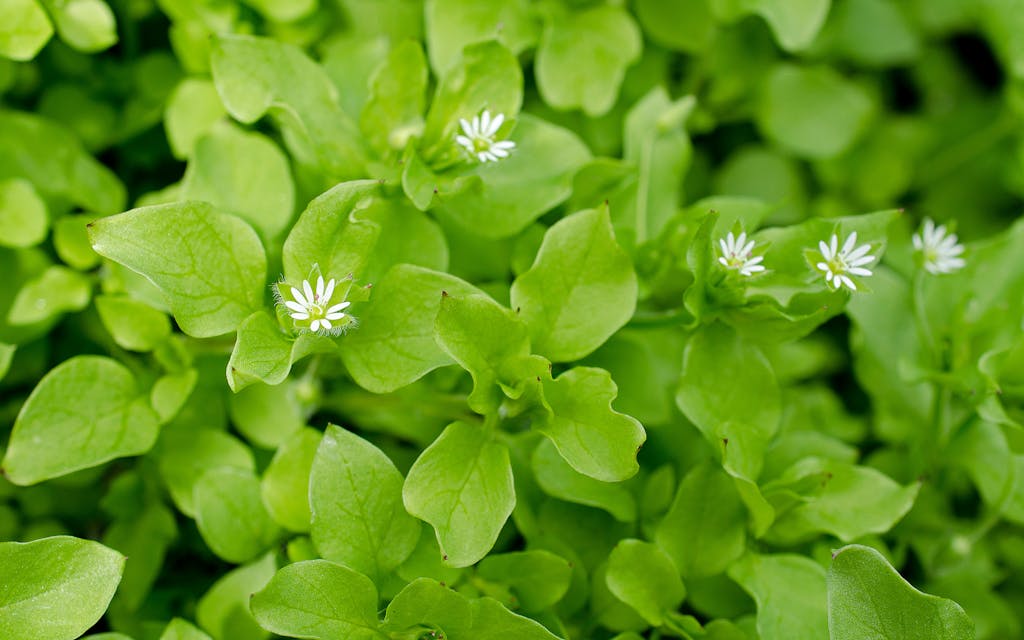
Chickweed
Range: Statewide
How to eat it: Blend into a pesto or add to smoothies
This humble green weed, which is found in abundance across Texas and the continental U.S., often grows up against the sides of houses. The plant usually pops up in late winter and early spring, though you can pick it year-round. With a texture similar to spinach, it’s a good addition to a sandwich or a salad; Vorderbruggen suggests adding it to a smoothie. “Chickweed has a creamifying effect that makes a vegan smoothie a little more decadent, more like a milkshake,” he says. “It’s good on its own, too, but I highly recommend it in that role.” The folks at Central Texas Gardener recommend using it in a pesto recipe.

Chile pequin
Range: Central and South Texas
How to eat it: In a salsa or jelly
Also known as bird pepper, chile pequin is ubiquitous across much of the state. You might even have one in your yard and not know it. “A lot of people cut them down because they don’t realize what they are,” Marshall says. Texas’s official (and only) state native pepper thrives in both sun and shade; in late summer or early fall, its round, green berries turn red and are ready to pick. Most of the hot peppers sold in grocery stores are descended from the chile pequin, Marshall and Cheatham note, including jalapeño and serrano. This little red chile, whose spiciness Texas Monthly’s Pat Sharpe once described as “incendiary,” is stellar in homemade salsa or jelly. Try our recipe for the latter, which cuts the heat with grapefruit.

Dewberry
Range: Central, East, and North Texas
How to eat it: Fresh off the vine, baked in a pie, or cooked in a jam
If you’re skeptical about eating strange and unusual wild plants, this one might be a comfortable place to start. The wild dewberry tastes and looks exactly like a blackberry, because it is one. “Genetically, it’s almost identical,” Vorderbruggen says. “Think of them as two different breeds of dogs.” Find the low-slung shrub growing along roads and highways, as well as in fields and thickets. You’ll want to wear gloves while picking these to avoid getting scratched by the thorns. Dewberry season is early and fleeting, lasting from late spring through early summer.

Horehound
Range: Central and West Texas
How to eat it: Brewed in a tea, or boiled down into a candy
A member of the mint family with medicinal properties, horehound is a great natural remedy for a sore throat or cough; cultures around the world have been using it for this purpose for thousands of years. You can brew the leaves into a tea or make a candy similar to a cough drop. Vorderbruggen describes the strong herbal flavor as a pleasant combination of root beer and licorice. His website has recipes for both horehound tea and horehound candy.

Jujube
Range: Statewide, especially Houston
How to eat it: On its own, fresh or dried
Jujube trees are originally from China; the U.S. Department of Agriculture introduced them to America in the early twentieth century. These hardy trees grow well in harsh, dry environments, so USDA officials thought they’d be a good option in California, Texas, and across the arid Southwest. Though it never became as popular as they’d hoped, the low-maintenance plant produces a sweet fruit that draws comparisons to apples, plums, and pears. “It does really well in the Houston area,” Vorderbruggen says, noting that a jujube harvest is usually a big one. “They are very prolific, producing pounds and pounds of fruit.” Unlike the sensitive pawpaw (see below), the fruit is sturdy and easy to transport or preserve. Dried jujubes taste a lot like dates. Can’t find one or don’t want to search on your own? Your local Asian grocer likely has them.
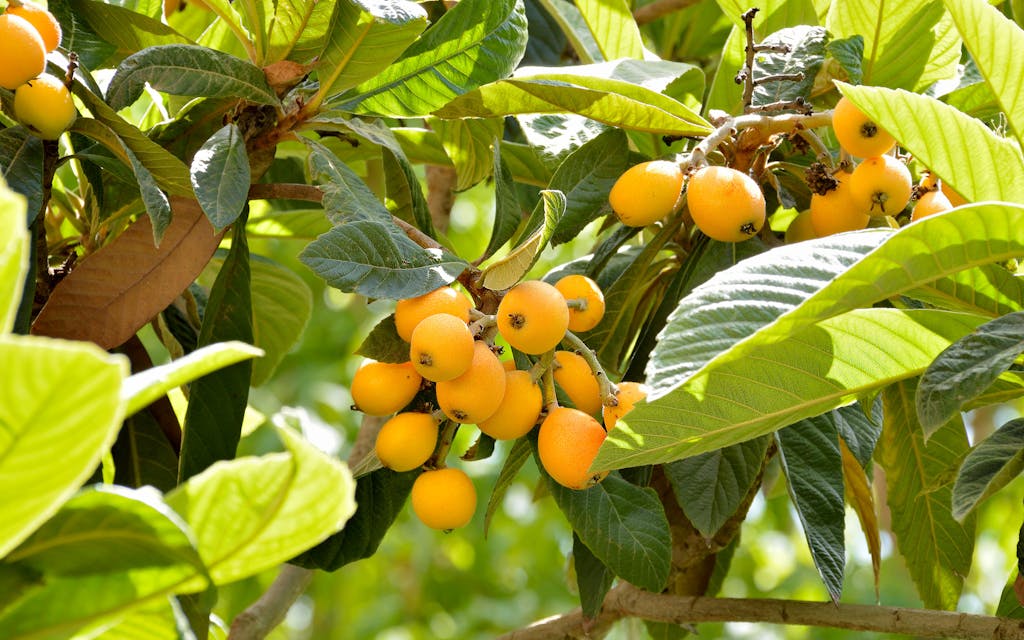
Loquat
Range: Statewide, especially South Texas
How to eat it: Fresh, in preserves, or as a liqueur
Another Asian import, cold-hardy loquats grow easily across much of the state. I always look forward to spotting the bright, sunflower-yellow fruits ripening all over my Austin neighborhood in late spring and early summer. While they’re lovely as an ornamental fruit, loquats also have a delicious flavor evoking that of apricots. When I received some in a produce box a few years back, I didn’t know what to do with them, and eventually settled on loquat margaritas, which were a hit. Peeling and preparing the fruit takes a little time but is well worth the effort. Joe Urbach of the San Marcos Daily Record suggests making loquat chutney or syrup, which brings a hit of sweetness to lemonade, iced tea, or the aforementioned margaritas. Vorderbruggen, meanwhile, has a recipe for loquat liqueur, which has an amaretto flavor.

Mayhaw
Range: East Texas
How to eat it: Cooked in a jam or jelly
Families in East Texas pass down time-honored jam recipes for this slightly tart red berry, which looks a lot like a cranberry and comes from a tree that’s part of the hawthorn family. At the Jellytree Mayhaw Farm in Huntington, Texas Highways’ Susan L. Ebert writes, you can take home not just an excellent mayhaw jelly, but also preserves with other local wild fruits, such as muscadine, beautyberry, and redbud blossom. Often found along the Trinity River and in other low-lying swampy areas, especially in the Big Thicket region, the tree is increasingly at risk from deforestation and disease. Vorderbruggen points out that the fruit naturally contains a high level of pectin, so you may not even need to add extra when making your own jam (though the folks at Jellytree swear by it).
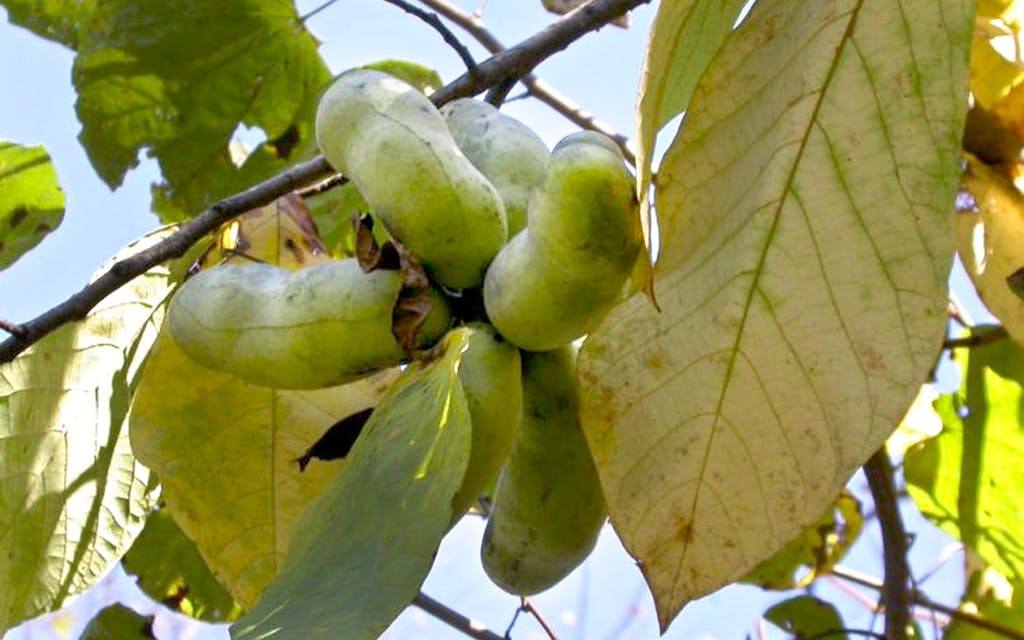
Pawpaw
Range: East Texas and Houston area
How to eat it: Straight off the tree
This elusive, ephemeral fruit has a tropical flavor that’s often compared to banana custard, mango, or pineapple. If you’re lucky enough to find one, give it a gentle squeeze to make sure it’s soft, and look for a light green or slightly yellow hue. Then, don’t hesitate. “The moment you pick the fruit, it starts to spoil,” Vorderbruggen says, “so you have a very short window of opportunity to enjoy it.” Wash and eat immediately after picking, scooping the fruit out with a spoon.
Because it spoils so quickly, pawpaw is rarely found in processed foods. A recent surge in popularity among young foragers has earned it the nickname “hipster banana,” but the fruit is nothing new—according to lore, it was one of George Washington’s favorite desserts. In fact, this ancient tree evolved before bees, so it’s pollinated by flies. The flowers attract them by emitting an atrocious odor similar to that of rotten meat. But flies aren’t as efficient as bees, so if you want to grow a pawpaw tree, you’ll have to help its unusual pollination process along. “Some gardeners have been successful by hanging strips of raw meat in the branches,” Vorderbruggen says. Thankfully, there’s a milder option: simply pollinate by hand with a small paintbrush, following these tips from the Dallas Morning News.
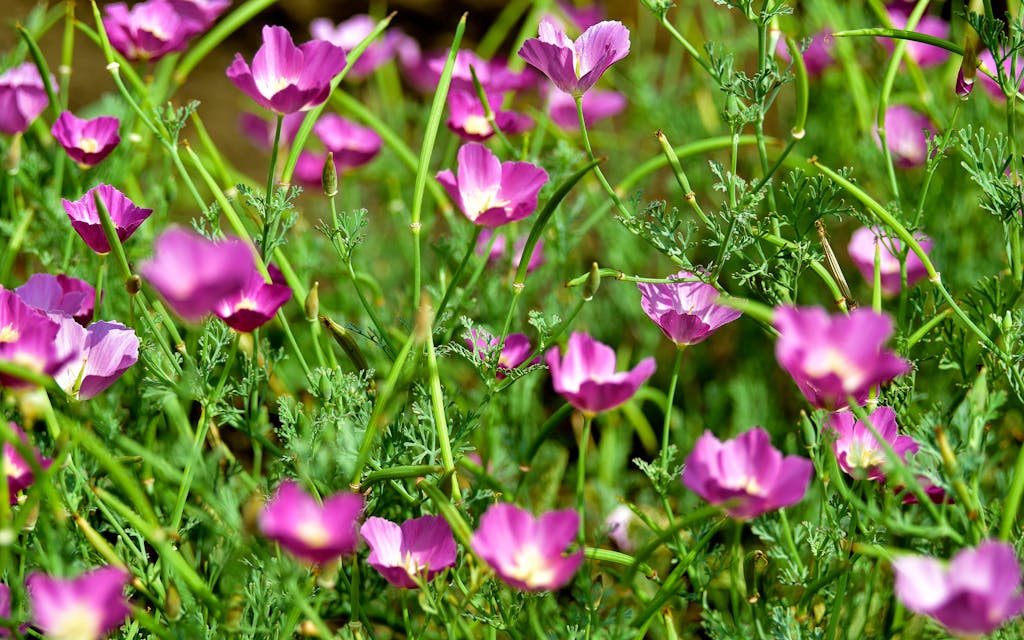
Winecup
Range: Statewide
How to eat it: In a salad (flowers) or as a crunchy snack (tubers)
Also called purple poppy mallow, this cheerful magenta flower is popular with gardeners because it’s easy to grow; the trailing vine spreads quickly, making it an excellent ground-cover plant. I’ve had it in my front yard for years, but never knew it was edible. Vorderbruggen suggests you stick to cultivating rather than foraging this plant, because harvesting it in the wild can be tricky. “They’re almost impossible to transplant,” he says. “So if you dig one up and damage the little fine roots coming off the tuber, it’s going to die.” Better to buy the seeds from Junction-based Native American Seed and grow your own.
Scatter the flowers in a salad or as a stylish decoration on a frosted cake. If you’re feeling more adventurous, slice the radishlike tubers thinly, then roast or fry them. “They taste just like sweet potatoes,” Vorderbruggen says. The Lady Bird Johnson Wildflower Center has a recipe for wild onion and winecup tuber stew.
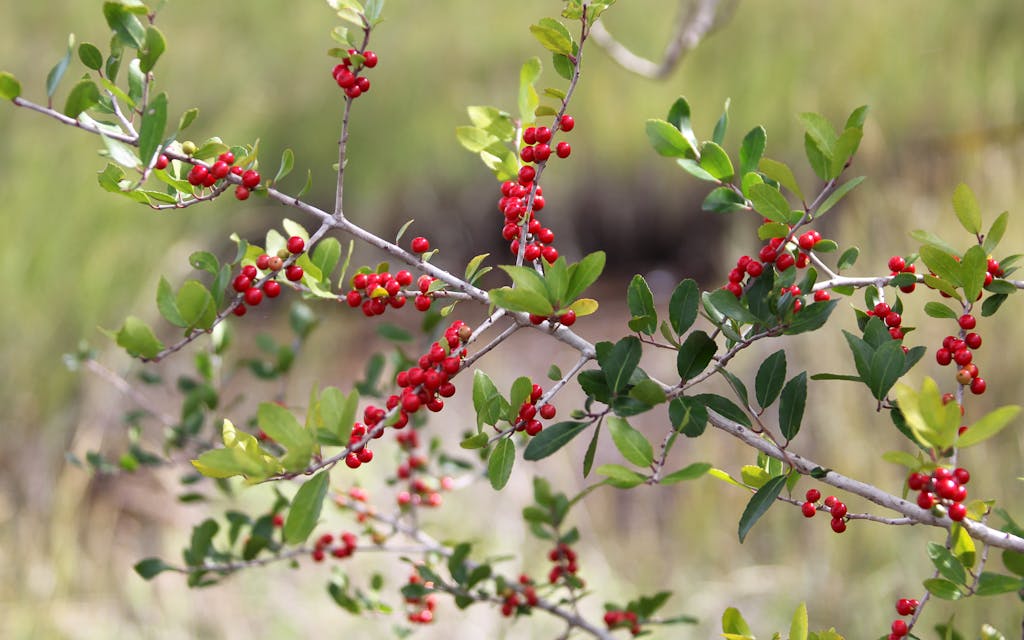
Yaupon holly
Range: East and Central Texas
How to eat it: Brewed in a tea
The only caffeinated plant native to North America, yaupon can be made into a beverage similar to green or black tea; Indigenous Texans have been drinking it for more than a thousand years. During World War II, when coffee and tea were in short supply, the federal government promoted it as a substitute, but the drink never really caught on. Now, a new generation of Texas tea makers is bringing it back. Buy yaupon tea premade from one of at least four brands—CatSpring Yaupon, Local Leaf, Lost Pines Yaupon, or YAYAYA Yaupon—or make your own. Yaupon holly grows in abundance anywhere sandy soil is found, especially in Central and East Texas. Simply cut a branch and remove enough leaves to spread on a cookie sheet, then bake at 350 degrees F for about twenty minutes. Crumble the leaves, put a few spoonfuls in a tea infuser, and add hot water.
Unlike tea, yaupon can’t be oversteeped. “The leaves have about fifty percent of the caffeine found in regular tea, but none of the tannins that make it bitter,” Vorderbruggen says, noting that the brew is also rich in antioxidants. “In the morning, I’ll put a handful of dried leaves in my mug and then just sip all day long.”
11 Texas Plants You Didn’t Know You Could Eat - Texas Monthly
Read More


No comments:
Post a Comment